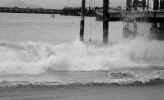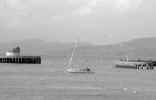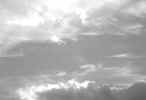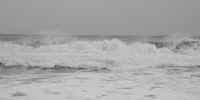San Francisco
January 15, 2025
Dear Aunt Susie,
You can’t believe the storms we’ve been having. The
rain poured down in sheets, making ponds out of the
potholes in the streets until I half-expected to see
tadpoles swimming at the intersection of Polk and
McAllister. I tried to take a walk the other afternoon,
but the wind was so strong that it bent the treetops like
a good old-fashioned Iowa tornado. The only way I could
make any progress at all was to walk sideways, making
myself as thin as possible.

People here say it’s what winter in the Bay Area is
supposed to be like. Some even welcome a deluge like the
one we had the other day. I suppose a climate where it
never rains from Easter to Thanksgiving can make a body a
bit nervous. Miss a couple of months’ precipitation, and
it’s all over till next year. Nevertheless, I kept
thinking of that old song — “The rain may never fall
till after sundown. By eight, the morning fog must
disappear.” That’s not the case in this Camelot. Here
the rain may never fall until November, and then it doesn’t
stop for clock or royal edict. And the morning fog…
There are days when you’re lucky to see the sun in time
for sunset.
Do I sound grumpy? I’m really having a wonderful
time, only there are mornings when my coat is still soggy
from the night before and my shoes are so perpetually damp
that I keep looking for signs of sprouting mushrooms. The
only thing that makes this misty misery bearable is the
days in between, when the sun shines brilliantly and the
city is washed clean. The buds on the plum trees start to
swell — yes, in January — and the gray-green branches
of the acacias grow heavy with yellow flowers. There’s a
mockingbird that likes to perch outside my window early in
the morning. He imitates every bird in the neighborhood,
one by one, stops for a moment, and then goes through
entire repertoire again in exactly the same order.
The place to go at this time of year is the beach. Not
to sunbathe. Not to swim, although the temperature of the
water is scarcely colder than it is in August. Serious
surfers are out there year-round, wearing not only
chin-to-ankle wetsuits but even bonnets to ward off
hypothermia. I stuck my hand into the edge of a wave, just
to see what their habitat felt like. My fingers didn’t
quite turn blue, but the tips were numb for several
minutes after I jammed them back in my pockets.

A trip to the beach in January is not for the
faint-hearted. If you want sun and warm sand, you’re
better off in Hawaii. This is the season when bay and
ocean declare their might, making it clear that no human
engineering can tame them. The summer winds on the bay
blow more fiercely, habitually reaching velocities that
would force the America’s Cup to close down shop for the
day. But winter storms roil the waters. And when a full
moon draws the tide exceptionally high on the shore, as it
did this week, a visitor can only tread carefully and
beware the power of the sea.
My new friend Simon took me to Aquatic Park on
Wednesday afternoon. As usual, his black garb contrasted
with the colorful clothes of the people around us, but on
this particular day he seemed less conspicuous, more like
a terrestrial counterpart of the seal that was bobbing out
near the breakwater. We sat on the cement steps near the
Maritime Museum, drinking cappuccinos and watching a flock
of seagulls occupy the harbor. I think you told me the
steps were there at the turn of the century, when you
visited San Francisco, and the museum was a remnant of the
1930s. The city has refurbished it, adding a deck with a
lookout tower, but it still houses a wonderful collection
of photographs and seamen’s belongings.
As we followed the progress of a swimmer, moving
determinedly from the Dolphin Club to Fort Mason, Simon
reminded me that European explorers had plied the
California coast for two centuries before a gap in the fog
revealed the presence of this bay. I wonder if they felt
stupid for missing it. Or just relieved that they now had
one more harbor to conduct their business in. I’ve seen
photographs taken in the middle of the 19th
century, where sailing ships crowd the area, their masts
black and straight like tree trunks in a burned-out
forest. Can you imagine the clatter that the rigging of
5,000 ships must have made? And what a nuisance it must
have been, in 1849, when entire crews jumped ship and
headed for the gold fields, leaving their vessels to rot
in the water. The folks who stayed in town made good use
of the abandoned hulls, though. They hauled them in to
shore and piled them every which way, taking advantage of
the salvage to create landfill. I guess you could say that
the early city of San Francisco rested both literally and
figuratively upon the maritime trade.
Even in the rain, small ketches were tacking back and
forth in front of us. Simon told me that, at the beginning
of the 21st century, the city nearly lost its
waterfront. The bay was lined with old, dilapidated piers
that had apparently lost their usefulness. The Port
Commission began accepting bids to develop them. A
waterside strip mall at Pier 39 had already led the way,
but by the beginning of the new millennium, the still
barely active Fisherman’s Wharf was in danger of
disappearing in the new construction. There were plans for
a hotel here, a retail complex there, even a San Francisco
history theme park and a high-priced sports complex. But
Adam Smith’s invisible hand reached out and pushed the
stop button. The economy went sour, and interest in
anything-goes development evaporated.
Now the waterfront is bustling, but tourists walk there
warily, lest they interfere. Cruise ships call on their
way down the coast or out to sea. Ships laden with logs
from the Northwest tie up farther south, near the railroad
terminus. Simon told me that, in fairer weather, this part
of the bay is filled with windsurfers and tiny boats
enjoying the excitement of sailing across the Golden Gate.
Fishing boats tie up at the Wharf and the Hyde Street Pier
in record numbers, their brimming holds a testimony to
years of clean-up efforts by local environmental
organizations. A few days later, I paid a visit to the
Powell Street Fish Market, where piles of crabs and
oysters sold for half their supermarket price.

As we left the beach, the weather grew fierce. Heavy
clouds hovered overhead. I found myself thinking
nostalgically of crisp snowy fields outside Des Moines. We
caught a cable car and headed downtown, arriving just
before another torrent of rain.
Simon walked me to my hotel, silent, obviously
considering something. He’s a strange man, with moods
that are hard to read. As we reached the entrance, he
stared at me for a minute.
“If I came by at 8:00 tomorrow morning, would you be
ready to go out?”
I said yes, puzzled. He refused to say anything more.
On Friday morning he appeared at precisely 8:00, behind
the wheel of a ShareCare. We drove down the coast to
Pacifica, where the newspaper said the waves had been
especially fierce.
They still were. As we stood at the upper edge of the
sand, the ocean drew back, rising 20 or 25 feet like a
rearing stallion. Waves broke high on the beach and left
behind debris, spread out in neat arcs. One wave thrust
through the narrow entrance to the parking lot, spewing a
giant tree trunk of seaweed and a decomposing seal’s
carcass onto the pavement.
If either of us had felt like talking, we would have
had to shout over the roar of the surf. But there are
times when words feel inappropriate. This puny pair of
humans knew when to keep quiet.

Then the wind came up, bringing more rain. Something
sharp stung my face. Hail. Simon took my hand and pulled
me across the sand toward the car. We climbed inside,
panting and dripping wet, exhausted, spent.
And then he drove me home.
Your loving niece,
Nedda Barbell
<>
<> <>
CYBERVOICES in this issue